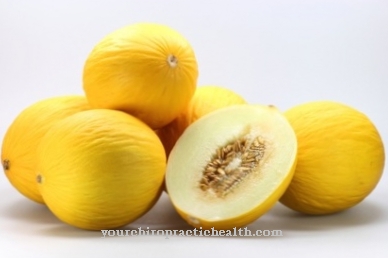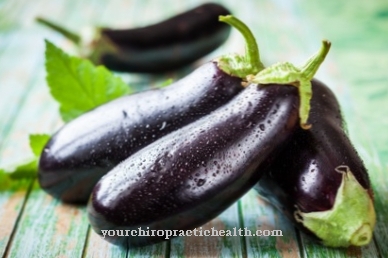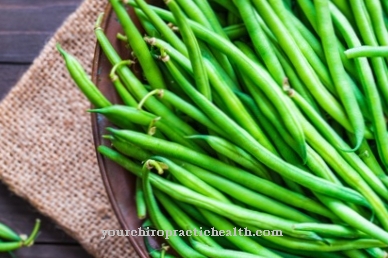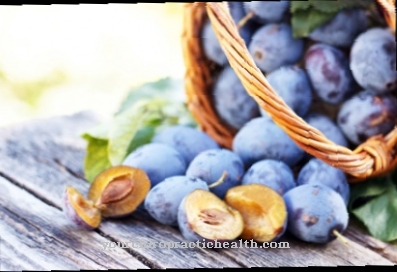Of the Bottle gourd, also Calabash, Jonas-, pilgrim-, Clubs- or Trumpet gourd called, is one of the oldest cultivated plants in the world. It is easy to cultivate and, due to its diverse, unusual shapes, is not only used for consumption, but also serves as a raw material for the production of vessels, musical instruments or other handicrafts.
What you should know about the bottle gourd

Like most pumpkin varieties, the bottle gourd is an annual climbing plant. It is believed to originally come from Africa and is particularly native to tropical and subtropical areas. The oldest finds in Central America document that the plant was there as early as the 8th millennium BC. was used.
Their fruits grow in a wide variety of sizes and shapes, which are mostly reminiscent of bottles or pears and were often used as watertight vessels. Young fruits whose skin is still soft and slightly hairy are suitable for consumption and can be harvested continuously. In Asia in particular, they are used for summer vegetables or curries. The flesh is white, watery, and has a delicate, mild taste. The climbing shoot tips of the plant and the peeled seeds are also edible.
The plants can be grown on the windowsill or in the greenhouse from mid to late April and planted out around mid May. Pay attention to a sunny location and sufficient space, also upwards, as the tendrils can be up to two meters high. When the fruits become bare and hard, they are no longer edible, but can be dried and processed into a wide variety of everyday objects or decorative items. Dried bottle gourds are very stable, waterproof and even heat and frost resistant. Therefore this material was used for water and storage vessels thousands of years ago.
The bottle gourd was also grown in Austrian wine-growing regions and used as a wine lifter. In South America it was decorated and carved by the Incas, a technique that can still be found in Peru today. It is also traditionally used as a container for South American mate tea. The processing of dried bottle gourds into various wind, plucked and percussion instruments is also very common, especially in South America, Africa and India.
Importance to health
It is not without good reason that the pumpkin has developed from the former poor people's food to a popular and, above all, very health-promoting food source. The pulp of the plant contains numerous healthy ingredients, valuable vitamins and minerals and is very low in calories due to its high water content and low carbohydrates.
In particular, the water content of the bottle gourd is even higher than that of other varieties; it is an average of 96% for the edible, young fruits. Steamed pumpkin meat is generally considered to be very digestible, easy to digest and rich in fiber, which makes it a suitable diet and reduction diet. Due to its low sodium content, it is also dehydrating and diuretic, which is why the pumpkin is often used to treat bladder and kidney diseases, as well as high blood pressure.
As a strong base-forming food, it is also a very popular dish in the field of deacidification and purification or the so-called alkaline diet. The bottle gourd in particular is of great medical importance, especially in Asia, where the ripe fruits are used against fever and nausea, as well as for dehydration. In the tropics, the leaves, flowers and seeds of the plant are also used for a wide variety of healing purposes, including jaundice and burns or as a laxative.
Ingredients & nutritional values
| Nutritional information | Amount per 100 gram |
| Calories 14 | Fat content 0 g |
| cholesterol 0 mg | sodium 2 mg |
| potassium 150 mg | carbohydrates 3.4 g |
| Fiber 0.5 g | protein 0.6 g |
Like most types of pumpkin, the bottle gourd is very low in carbohydrates and calories due to its high water content, but at the same time rich in potassium, calcium and other valuable nutrients and vitamins, especially vitamin C.
100g bottle gourd contains about 4.8 μg vitamin A, 10.1 mg vitamin C, 26 mg calcium, 0.2 mg iron and 11 mg magnesium. Bottle gourd seeds contain around 1% steroids, 35-50% oil, 25-40% protein and 10% carbohydrates.
Intolerances & allergies
Pumpkins are generally known to be low in histamine, which means that allergies and intolerances are rare. However, as with other cucurbits, there is a risk of allergy in the form of cross-allergy.
This means that people who are allergic to pollen are often allergic to certain foods at the same time. In the case of pumpkins, this occurs especially in combination with allergies to grass, plantain, mugwort and olive tree.Pumpkin seeds can also trigger allergies, affecting people who are also allergic to other seeds, nuts or sumac plants (mango, pistachio, pink pepper), or people who are in daily contact with pumpkin seeds at work.
Shopping & kitchen tips
Fresh bottle gourds can hardly be found in the normal trade in Central and Northern Europe, but with a bit of luck they can be found in Asian delicatessen and specialty shops. The far more easily available seeds of the plant can easily be grown in your own garden.
The young fruits, as well as the tips of the shoots (with 2 to 3 leaves) are continuously harvested and cooked as vegetables. When the pumpkin is ripe, its skin becomes wooden and very hard, in this state the fruit is no longer edible, but can be dried and processed into a wide variety of objects. In addition to the usual processing as a vegetable, the pulp can also be dried; in Japan, for example, small edible casings for finger food are made in this way.
The seeds of the plant can also be dried or processed, for example ground into a kind of quark. Oil can of course also be obtained from them by pressing. The dried bottle gourd has a slightly different, but not less important, importance in the kitchen. The mate tea, which is particularly widespread in South America, is traditionally drunk from the end of the stem of a dried calabash. Once dried, these vessels have a very long shelf life, usually decades.
Preparation tips
As already mentioned, only the young fruits of the bottle gourd are suitable for consumption. As with all other types of pumpkin, there are no limits to creativity. The soft pulp can either simply be fried in the pan, for example with curries, or baked in oil, as in old Italian recipes for “cucurbita fricta”.
The fresh calabash can also be used for preparation in the oven, alone or filled, as well as for numerous traditional or exotic mashed dishes. If you want something a little more unusual, you can process the cooked pumpkin into puree and use it together with eggs, milk, sugar, vanilla and ginger as a filling for a pumpkin pie.



























